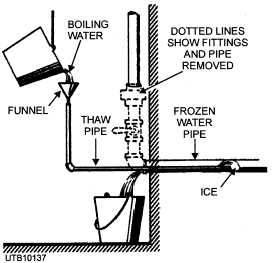used to stop small holes in a main. These plugs can be replaced later with metal plugs, or repairs may be made by other means. Wooden plugs can also be used temporarily to plug the ends of a pipe up to 8 inches in diameter, but such plugs must be braced to withstand existing main pressure. After repairs are completed, the main must be disinfected. Disinfection was discussed earlier in chapter 1 of this training module.
THAWING FROZEN PIPES
In cold weather, a water-supply system can freeze. Because of the lack of protection against freezing, and, sometimes regardless of it, pipes frequently freeze in Temperate Zones. When this happens, the pipes must be thawed. Breaks must be found, if possible, before natural thawing to prevent damage to material and property. Alert personnel to watch for the signs of a broken line. The prevention of freezing pipes can sometimes be accomplished by using heat tapes and cables.
Before starting to thaw a frozen pipe, open faucets affected by the freeze. Frozen pipes can be thawed by applying heat at the lowest open end of the frozen section. (Do NOT start in the middle of a frozen section because a pocket of steam could develop and an explosion or damage to the pipe can occur.) Where there is no danger of fire, simply heat the pipe with a blowtorch, applying the flame on the outside of the pipe.
When thawing frozen water pipes or heating pipes inside of buildings, use hot water. Do NOT use an open flame. A safe method is to wrap the frozen section of pipe with cloth and pour hot water on it until the ice gives way. Remember to protect the floor by catching the water in buckets or by covering the floor with material to absorb the water.
A good method of thawing water pipes that are underground or otherwise hard to get to is shown in figure 5-35. When using this method, remove the fittings (see illustration) and insert one end of the small pipe or tube into the frozen pipe. Now add an elbow and a piece of vertical pipe to the outer end of the thaw pipe. Place a bucket under the opening to the frozen pipe and insert a funnel in the open end of the vertical pipe. With that done, start pouring boiling water through the funnel into the pipe. As the ice melts, push the thawed pipe forward. Where necessary, add pipe at the outer end until a passage is made through the ice.

Figure 5-35. - Thawing an underground or otherwise inaccessible pipe.
Withdraw the thaw pipe quickly after the flow starts and do not stop the flow until the thaw pipe is fully removed and the pipe cleared of ice.
Instead of a funnel, a small force pump can be used. This pump is useful for thawing a long piece of pipe. When available, you can use steam in place of hot water. The above method can also be used without the elbow and piece of vertical pipe shown in figure 5-35. Simply connect the funnel to the outer end of the thaw pipe with rubber tubing. Have the tubing long enough so you can hold the funnel above the level of the frozen pipe. In this way, you give the hot water a head, forcing the cooled water back to the opening where it runs out into the pail. Hence the advantage of the elbow and vertical pipe is that they increase the head of the water and make the use of the funnel easier.
Electrical Thawing
Electrical thawing of frozen service lines is quick and cheap. The electrical current for the thawing operation consists of a source of current (a dc generator, such as a welding outfit, or a transformer connected to an ac outlet) and two insulated wires connecting the current source and the pipe (fig. 5-36). Only qualified personnel should use power lines as a source of current. As current flows through the pipe, heat is generated, and the ice within the pipe begins to melt. As the water starts to flow, the rest of the ice is melted by contact with the flowing water. The wires from the current source may be connected to nearby hydrants, valves, or exposed points at the ends of
Continue Reading